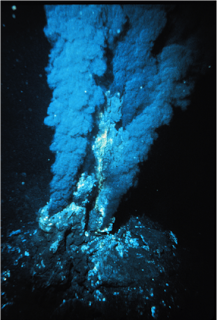Hydrothermal vents behave like geysers at a national park, except that they erupt deep underwater in the Pacific and Atlantic Oceans. Though the water that shoots out of these vents can reach temperatures as high as 300°C (572°F), many animals and other organisms thrive in the surrounding area.

Black smoker at a mid-ocean ridge hydrothermal vent.
(Image by P. Rona/OAR/National Undersea Research Program (NURP); NOAA)
Two such extremophiles are “palm worms,” named for their resemblance to tiny palm trees. To learn more about these worms’ tolerances for the high temperatures around the deep-sea vents, researchers led by DOE JGI collaborator Peter Girguisof Harvard conducted a series of experiments on two examples, Paralvinellasulfincolaand P. palmiformis, collected from hydrothermal vents located 2.2 kilometers underwater and off the Pacific Northwest coast.
In the paper published online May 2, 2012 in the Proceedings of the Royal Society B journal, the researchers found that while the two worms had overlapping thermal tolerances, they employed different strategies to deal with high temperatures close to their tolerance limits. For example, P. sulfincola’sstrategy involves adapting to varying oxygen concentrations in its environment so it can decrease its aerobic metabolism.
Girguisis also leading a DOE JGI 2011 Community Sequencing Program project to develop a metagenomic database of the microbial communities that thrive around hydrothermal vents. The database is expected to provide an inventory of novel gene sequences that will aid research in renewable energy, carbon and heavy metal sequestration, and environmental remediation.